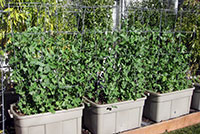Choosing a Container for Your Plant

Container gardens are versatile and can beautify any part of your home or landscape. But what should you put your plants in?
First, the basics: a good container should be large enough to provide room for soil and roots, and be attractive without competing with the plant it holds. You don’t want your plant standing in wet soil, so make sure the container you choose has enough drainage holes. Plan ahead when planting large containers and add dollies with wheels so that it can be easily moved.
Using Everyday Items as Containers
Half the fun of gardening is getting to express yourself, and containing gardening is no exception. Anything can be used, from a hollow log to an antique urn. The only thing that limits your container selection is your imagination.
Taking common objects and turning them into garden features makes a great personal statement. Everyday items, such as chairs, watering cans, or even boots can make great container gardens. Any object that holds potting soil and provides drainage is a possible container. You can either transform the item into a container or place a container inside of it. Sometimes drain holes can be drilled, but this depends on the container material. Just remember, the smaller the container, the more often it will need to be watered.
Decorating Containers Yourself
Garden centers sell plenty of beautiful pots for container gardening, but they may not always have what you want. Why not get the look you want by decorating your own containers? Transform a boring plastic pot into a bold, colorful one using a few coats of spray paint. Be sure to use a paint or primer that’s designed for plastics. Add color to a clay pot by decorating it with a broken tile mosaic. Just keep in mind that a mosaic will make the pot heavier. If you prefer the look of old terra-cotta pots, you can try these two tricks. Rubbing a new pot with wood stain will give it an antiqued look, and coating a pot with yogurt gives it an earthy patina.
Hanging Baskets
Hanging baskets bring plants to eye level and bring vertical interest to your home and landscape. There are many types of hanging containers available, including lined wire baskets, plastic containers, and terra-cotta pots. Use a well-drained media and water as needed. Baskets outside will require more frequent watering.
Hanging baskets are a great choice for cascading plants, and you can add other plants in as well. Narrow-leaved bromeliads or ferns are good choices. Bright, cheery annuals like trailing vinca and ivy geraniums do well in the sun, while coleus, wax begonias, and impatiens prefer the shade.
Grow Boxes

Grow boxes are enclosed systems for growing vegetables and herbs, and are reusable and portable. They yield excellent crops within weeks and are perfect for gardeners with limited space. Grow boxes are easy and inexpensive to make, although you can also purchase them. Grow boxes differ from other container gardens in that they have a water reservoir and a fertilizer charge, so once you plant, there’s little to no maintenance.
Grow boxes are typically used for vegetables, and you have many options for which you can grow.
Winter veggies like lettuce and other greens can be grown, and in the spring, melons, tomatoes, and peppers are great choices. Place your grow box where it’ll receive at least six hours of direct sunlight.

Hypertufa
Love the look of stone, but not the weight and expense? With a little time and a few supplies, you can make your own planters from hypertufa.
Hypertufa is a mix of water, Portland cement, peat moss or coconut fiber, and either sand, perlite, or vermiculite.
Planters made from hypertufa are porous and drain well, so they make a perfect home for succulents and rock garden plants.
The hypertufa mix is molded into a form and left to cure. Everyday items like bowls, boxes, or plastic bins can be used as forms. Don’t forget to poke a few drainage holes into the bottom. The process can be messy, so it’s best to work outside wearing gloves and old clothes. Oregon State University Extension has an excellent article on making hypertufa.
